Creating Workplace Guidance for Dementia Care in Health & Social Care
VerifiedAdded on 2023/06/11
|6
|1500
|251
Report
AI Summary
This report focuses on providing effective care to dementia patients in a residential home setting. It addresses risk and hazard management, emphasizing the importance of patient health, well-being, and safety. The report outlines relevant health and safety legislation, policies, and procedures, including the Health and Safety at Work Act 1974 and the Health and Social Care Act 2008. It also discusses the roles and responsibilities of employers, employees, service users, and visitors, as defined by the Care Quality Commission (CQC). Key priorities include implementing CCTV, providing mobility aids, and ensuring fire safety. This guidance aims to equip new staff with the knowledge and tools necessary to deliver optimal care to dementia patients, ensuring their safety and dignity. Desklib offers similar solved assignments and past papers for students.
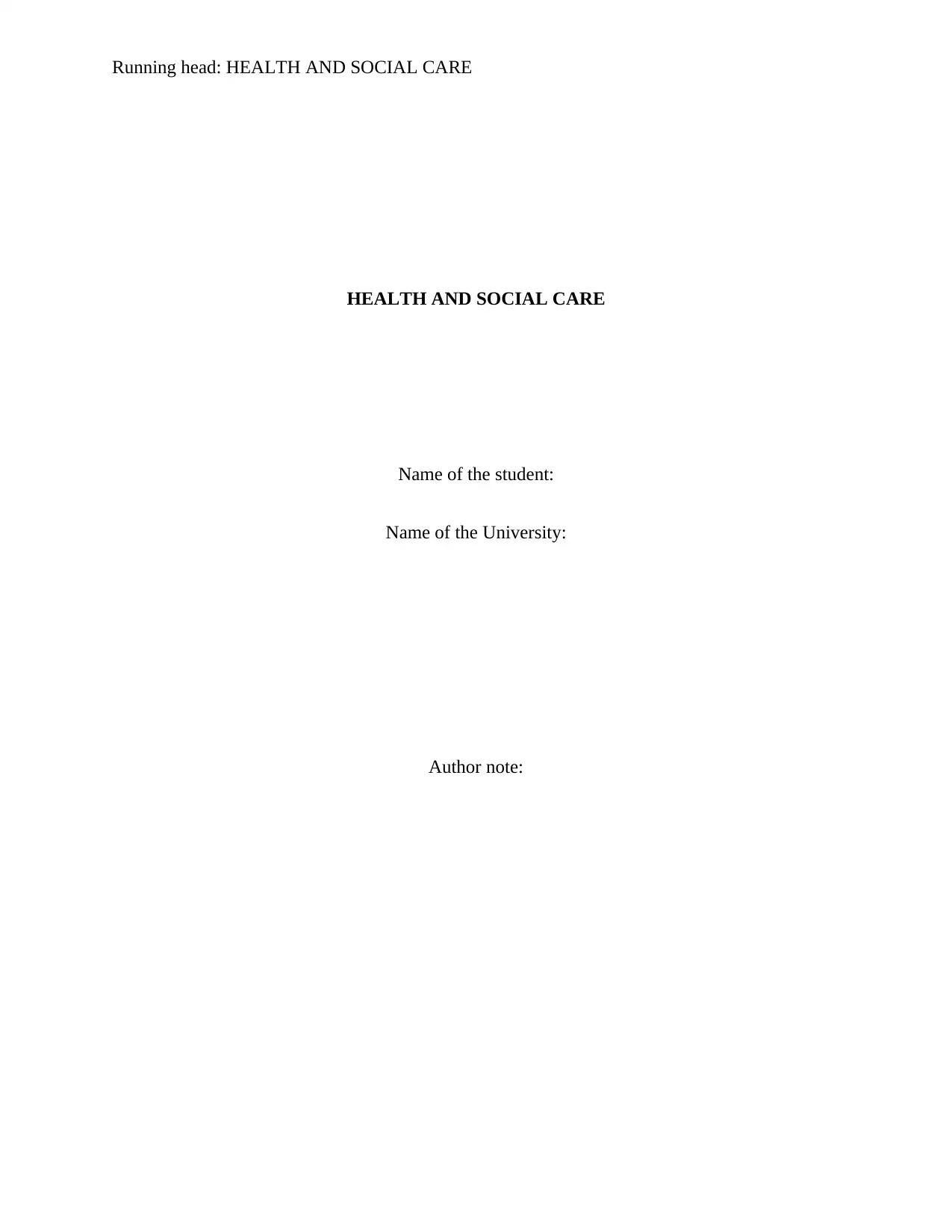
Running head: HEALTH AND SOCIAL CARE
HEALTH AND SOCIAL CARE
Name of the student:
Name of the University:
Author note:
HEALTH AND SOCIAL CARE
Name of the student:
Name of the University:
Author note:
Paraphrase This Document
Need a fresh take? Get an instant paraphrase of this document with our AI Paraphraser
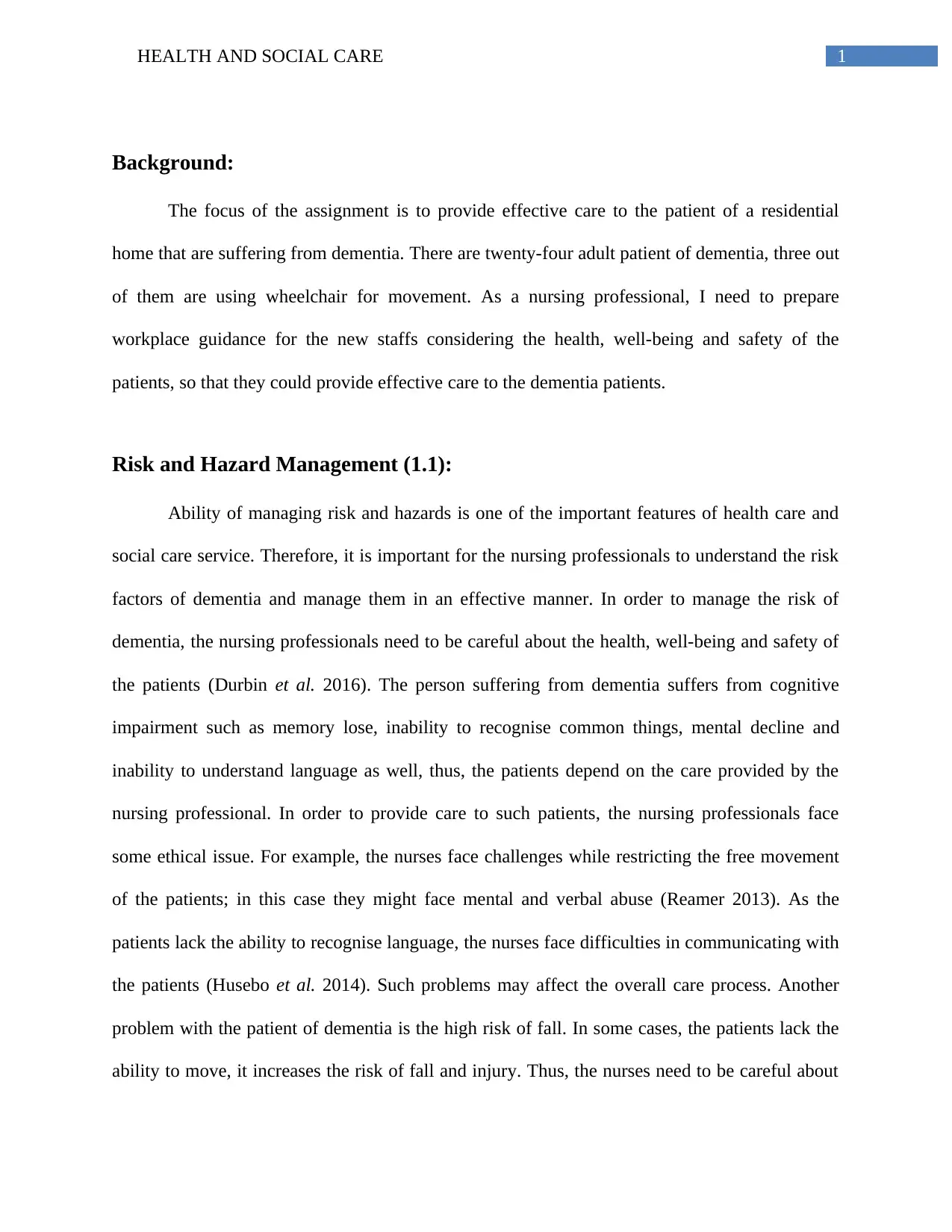
1HEALTH AND SOCIAL CARE
Background:
The focus of the assignment is to provide effective care to the patient of a residential
home that are suffering from dementia. There are twenty-four adult patient of dementia, three out
of them are using wheelchair for movement. As a nursing professional, I need to prepare
workplace guidance for the new staffs considering the health, well-being and safety of the
patients, so that they could provide effective care to the dementia patients.
Risk and Hazard Management (1.1):
Ability of managing risk and hazards is one of the important features of health care and
social care service. Therefore, it is important for the nursing professionals to understand the risk
factors of dementia and manage them in an effective manner. In order to manage the risk of
dementia, the nursing professionals need to be careful about the health, well-being and safety of
the patients (Durbin et al. 2016). The person suffering from dementia suffers from cognitive
impairment such as memory lose, inability to recognise common things, mental decline and
inability to understand language as well, thus, the patients depend on the care provided by the
nursing professional. In order to provide care to such patients, the nursing professionals face
some ethical issue. For example, the nurses face challenges while restricting the free movement
of the patients; in this case they might face mental and verbal abuse (Reamer 2013). As the
patients lack the ability to recognise language, the nurses face difficulties in communicating with
the patients (Husebo et al. 2014). Such problems may affect the overall care process. Another
problem with the patient of dementia is the high risk of fall. In some cases, the patients lack the
ability to move, it increases the risk of fall and injury. Thus, the nurses need to be careful about
Background:
The focus of the assignment is to provide effective care to the patient of a residential
home that are suffering from dementia. There are twenty-four adult patient of dementia, three out
of them are using wheelchair for movement. As a nursing professional, I need to prepare
workplace guidance for the new staffs considering the health, well-being and safety of the
patients, so that they could provide effective care to the dementia patients.
Risk and Hazard Management (1.1):
Ability of managing risk and hazards is one of the important features of health care and
social care service. Therefore, it is important for the nursing professionals to understand the risk
factors of dementia and manage them in an effective manner. In order to manage the risk of
dementia, the nursing professionals need to be careful about the health, well-being and safety of
the patients (Durbin et al. 2016). The person suffering from dementia suffers from cognitive
impairment such as memory lose, inability to recognise common things, mental decline and
inability to understand language as well, thus, the patients depend on the care provided by the
nursing professional. In order to provide care to such patients, the nursing professionals face
some ethical issue. For example, the nurses face challenges while restricting the free movement
of the patients; in this case they might face mental and verbal abuse (Reamer 2013). As the
patients lack the ability to recognise language, the nurses face difficulties in communicating with
the patients (Husebo et al. 2014). Such problems may affect the overall care process. Another
problem with the patient of dementia is the high risk of fall. In some cases, the patients lack the
ability to move, it increases the risk of fall and injury. Thus, the nurses need to be careful about
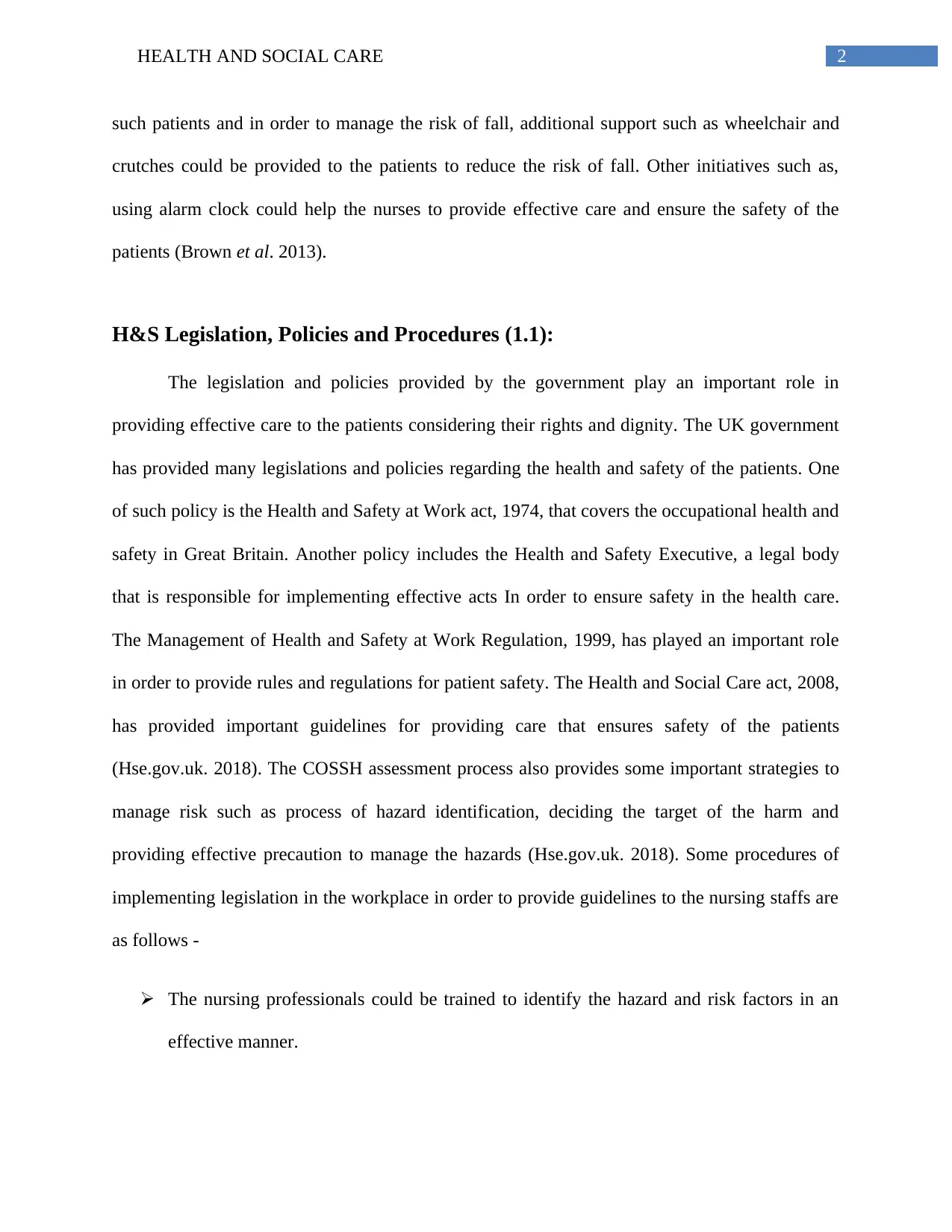
2HEALTH AND SOCIAL CARE
such patients and in order to manage the risk of fall, additional support such as wheelchair and
crutches could be provided to the patients to reduce the risk of fall. Other initiatives such as,
using alarm clock could help the nurses to provide effective care and ensure the safety of the
patients (Brown et al. 2013).
H&S Legislation, Policies and Procedures (1.1):
The legislation and policies provided by the government play an important role in
providing effective care to the patients considering their rights and dignity. The UK government
has provided many legislations and policies regarding the health and safety of the patients. One
of such policy is the Health and Safety at Work act, 1974, that covers the occupational health and
safety in Great Britain. Another policy includes the Health and Safety Executive, a legal body
that is responsible for implementing effective acts In order to ensure safety in the health care.
The Management of Health and Safety at Work Regulation, 1999, has played an important role
in order to provide rules and regulations for patient safety. The Health and Social Care act, 2008,
has provided important guidelines for providing care that ensures safety of the patients
(Hse.gov.uk. 2018). The COSSH assessment process also provides some important strategies to
manage risk such as process of hazard identification, deciding the target of the harm and
providing effective precaution to manage the hazards (Hse.gov.uk. 2018). Some procedures of
implementing legislation in the workplace in order to provide guidelines to the nursing staffs are
as follows -
The nursing professionals could be trained to identify the hazard and risk factors in an
effective manner.
such patients and in order to manage the risk of fall, additional support such as wheelchair and
crutches could be provided to the patients to reduce the risk of fall. Other initiatives such as,
using alarm clock could help the nurses to provide effective care and ensure the safety of the
patients (Brown et al. 2013).
H&S Legislation, Policies and Procedures (1.1):
The legislation and policies provided by the government play an important role in
providing effective care to the patients considering their rights and dignity. The UK government
has provided many legislations and policies regarding the health and safety of the patients. One
of such policy is the Health and Safety at Work act, 1974, that covers the occupational health and
safety in Great Britain. Another policy includes the Health and Safety Executive, a legal body
that is responsible for implementing effective acts In order to ensure safety in the health care.
The Management of Health and Safety at Work Regulation, 1999, has played an important role
in order to provide rules and regulations for patient safety. The Health and Social Care act, 2008,
has provided important guidelines for providing care that ensures safety of the patients
(Hse.gov.uk. 2018). The COSSH assessment process also provides some important strategies to
manage risk such as process of hazard identification, deciding the target of the harm and
providing effective precaution to manage the hazards (Hse.gov.uk. 2018). Some procedures of
implementing legislation in the workplace in order to provide guidelines to the nursing staffs are
as follows -
The nursing professionals could be trained to identify the hazard and risk factors in an
effective manner.
⊘ This is a preview!⊘
Do you want full access?
Subscribe today to unlock all pages.

Trusted by 1+ million students worldwide
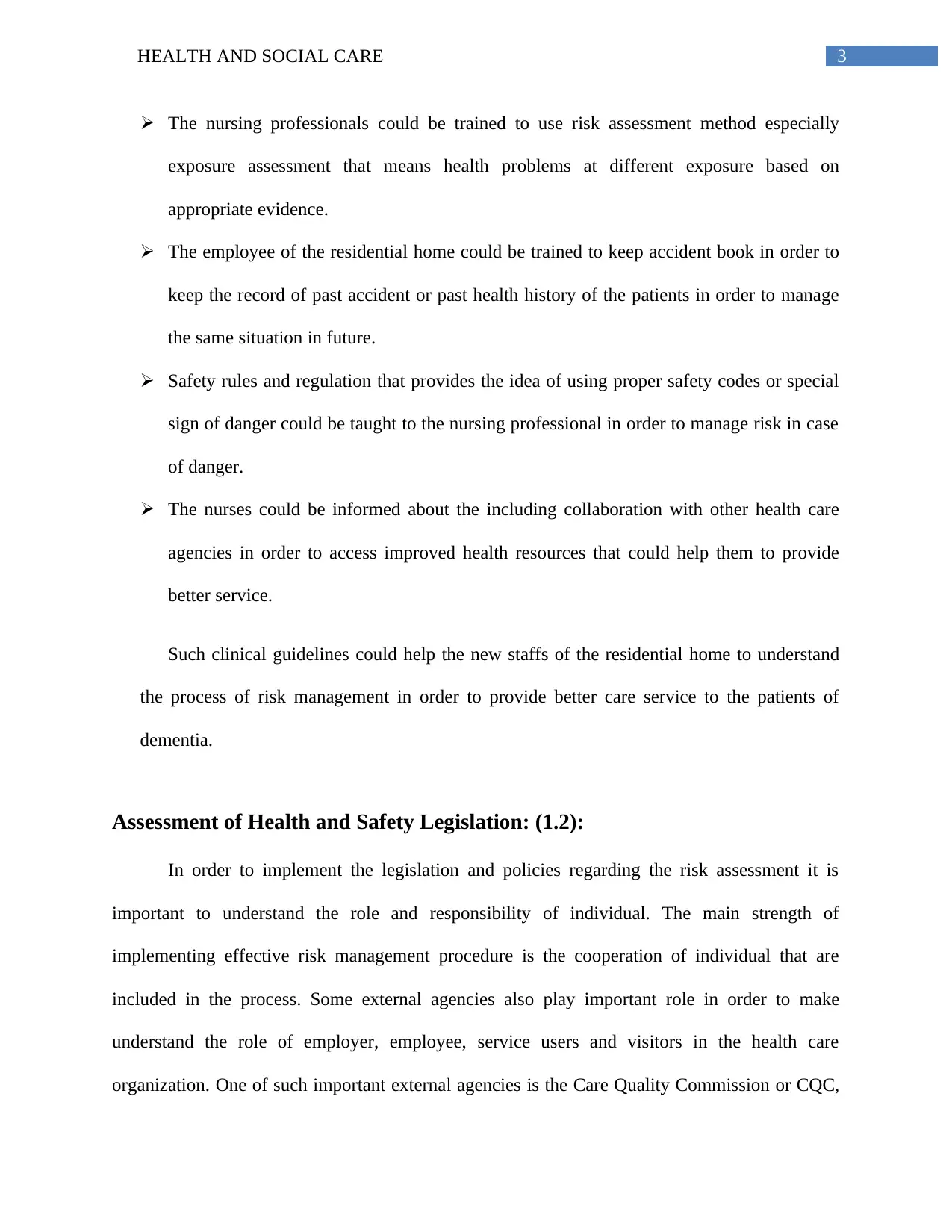
3HEALTH AND SOCIAL CARE
The nursing professionals could be trained to use risk assessment method especially
exposure assessment that means health problems at different exposure based on
appropriate evidence.
The employee of the residential home could be trained to keep accident book in order to
keep the record of past accident or past health history of the patients in order to manage
the same situation in future.
Safety rules and regulation that provides the idea of using proper safety codes or special
sign of danger could be taught to the nursing professional in order to manage risk in case
of danger.
The nurses could be informed about the including collaboration with other health care
agencies in order to access improved health resources that could help them to provide
better service.
Such clinical guidelines could help the new staffs of the residential home to understand
the process of risk management in order to provide better care service to the patients of
dementia.
Assessment of Health and Safety Legislation: (1.2):
In order to implement the legislation and policies regarding the risk assessment it is
important to understand the role and responsibility of individual. The main strength of
implementing effective risk management procedure is the cooperation of individual that are
included in the process. Some external agencies also play important role in order to make
understand the role of employer, employee, service users and visitors in the health care
organization. One of such important external agencies is the Care Quality Commission or CQC,
The nursing professionals could be trained to use risk assessment method especially
exposure assessment that means health problems at different exposure based on
appropriate evidence.
The employee of the residential home could be trained to keep accident book in order to
keep the record of past accident or past health history of the patients in order to manage
the same situation in future.
Safety rules and regulation that provides the idea of using proper safety codes or special
sign of danger could be taught to the nursing professional in order to manage risk in case
of danger.
The nurses could be informed about the including collaboration with other health care
agencies in order to access improved health resources that could help them to provide
better service.
Such clinical guidelines could help the new staffs of the residential home to understand
the process of risk management in order to provide better care service to the patients of
dementia.
Assessment of Health and Safety Legislation: (1.2):
In order to implement the legislation and policies regarding the risk assessment it is
important to understand the role and responsibility of individual. The main strength of
implementing effective risk management procedure is the cooperation of individual that are
included in the process. Some external agencies also play important role in order to make
understand the role of employer, employee, service users and visitors in the health care
organization. One of such important external agencies is the Care Quality Commission or CQC,
Paraphrase This Document
Need a fresh take? Get an instant paraphrase of this document with our AI Paraphraser
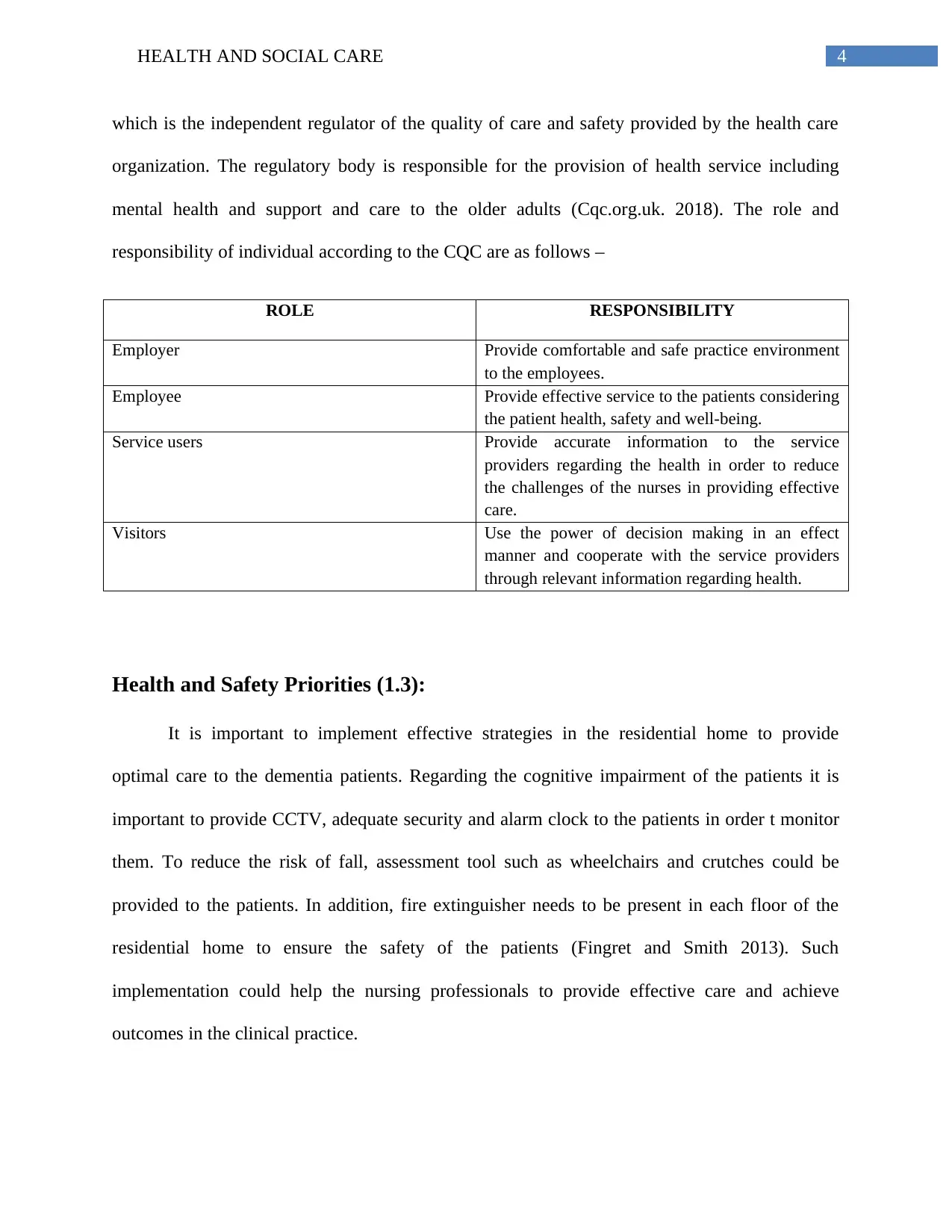
4HEALTH AND SOCIAL CARE
which is the independent regulator of the quality of care and safety provided by the health care
organization. The regulatory body is responsible for the provision of health service including
mental health and support and care to the older adults (Cqc.org.uk. 2018). The role and
responsibility of individual according to the CQC are as follows –
ROLE RESPONSIBILITY
Employer Provide comfortable and safe practice environment
to the employees.
Employee Provide effective service to the patients considering
the patient health, safety and well-being.
Service users Provide accurate information to the service
providers regarding the health in order to reduce
the challenges of the nurses in providing effective
care.
Visitors Use the power of decision making in an effect
manner and cooperate with the service providers
through relevant information regarding health.
Health and Safety Priorities (1.3):
It is important to implement effective strategies in the residential home to provide
optimal care to the dementia patients. Regarding the cognitive impairment of the patients it is
important to provide CCTV, adequate security and alarm clock to the patients in order t monitor
them. To reduce the risk of fall, assessment tool such as wheelchairs and crutches could be
provided to the patients. In addition, fire extinguisher needs to be present in each floor of the
residential home to ensure the safety of the patients (Fingret and Smith 2013). Such
implementation could help the nursing professionals to provide effective care and achieve
outcomes in the clinical practice.
which is the independent regulator of the quality of care and safety provided by the health care
organization. The regulatory body is responsible for the provision of health service including
mental health and support and care to the older adults (Cqc.org.uk. 2018). The role and
responsibility of individual according to the CQC are as follows –
ROLE RESPONSIBILITY
Employer Provide comfortable and safe practice environment
to the employees.
Employee Provide effective service to the patients considering
the patient health, safety and well-being.
Service users Provide accurate information to the service
providers regarding the health in order to reduce
the challenges of the nurses in providing effective
care.
Visitors Use the power of decision making in an effect
manner and cooperate with the service providers
through relevant information regarding health.
Health and Safety Priorities (1.3):
It is important to implement effective strategies in the residential home to provide
optimal care to the dementia patients. Regarding the cognitive impairment of the patients it is
important to provide CCTV, adequate security and alarm clock to the patients in order t monitor
them. To reduce the risk of fall, assessment tool such as wheelchairs and crutches could be
provided to the patients. In addition, fire extinguisher needs to be present in each floor of the
residential home to ensure the safety of the patients (Fingret and Smith 2013). Such
implementation could help the nursing professionals to provide effective care and achieve
outcomes in the clinical practice.
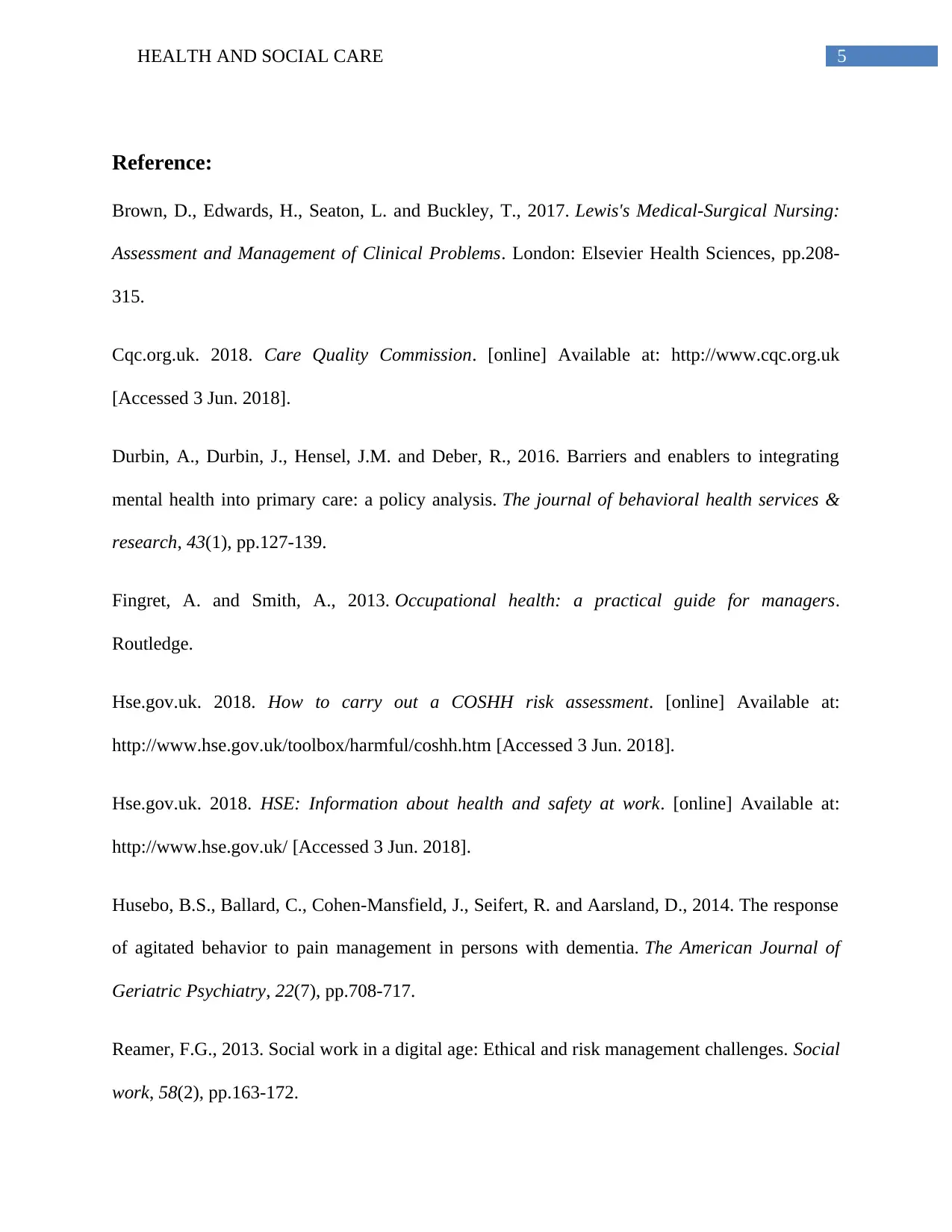
5HEALTH AND SOCIAL CARE
Reference:
Brown, D., Edwards, H., Seaton, L. and Buckley, T., 2017. Lewis's Medical-Surgical Nursing:
Assessment and Management of Clinical Problems. London: Elsevier Health Sciences, pp.208-
315.
Cqc.org.uk. 2018. Care Quality Commission. [online] Available at: http://www.cqc.org.uk
[Accessed 3 Jun. 2018].
Durbin, A., Durbin, J., Hensel, J.M. and Deber, R., 2016. Barriers and enablers to integrating
mental health into primary care: a policy analysis. The journal of behavioral health services &
research, 43(1), pp.127-139.
Fingret, A. and Smith, A., 2013. Occupational health: a practical guide for managers.
Routledge.
Hse.gov.uk. 2018. How to carry out a COSHH risk assessment. [online] Available at:
http://www.hse.gov.uk/toolbox/harmful/coshh.htm [Accessed 3 Jun. 2018].
Hse.gov.uk. 2018. HSE: Information about health and safety at work. [online] Available at:
http://www.hse.gov.uk/ [Accessed 3 Jun. 2018].
Husebo, B.S., Ballard, C., Cohen-Mansfield, J., Seifert, R. and Aarsland, D., 2014. The response
of agitated behavior to pain management in persons with dementia. The American Journal of
Geriatric Psychiatry, 22(7), pp.708-717.
Reamer, F.G., 2013. Social work in a digital age: Ethical and risk management challenges. Social
work, 58(2), pp.163-172.
Reference:
Brown, D., Edwards, H., Seaton, L. and Buckley, T., 2017. Lewis's Medical-Surgical Nursing:
Assessment and Management of Clinical Problems. London: Elsevier Health Sciences, pp.208-
315.
Cqc.org.uk. 2018. Care Quality Commission. [online] Available at: http://www.cqc.org.uk
[Accessed 3 Jun. 2018].
Durbin, A., Durbin, J., Hensel, J.M. and Deber, R., 2016. Barriers and enablers to integrating
mental health into primary care: a policy analysis. The journal of behavioral health services &
research, 43(1), pp.127-139.
Fingret, A. and Smith, A., 2013. Occupational health: a practical guide for managers.
Routledge.
Hse.gov.uk. 2018. How to carry out a COSHH risk assessment. [online] Available at:
http://www.hse.gov.uk/toolbox/harmful/coshh.htm [Accessed 3 Jun. 2018].
Hse.gov.uk. 2018. HSE: Information about health and safety at work. [online] Available at:
http://www.hse.gov.uk/ [Accessed 3 Jun. 2018].
Husebo, B.S., Ballard, C., Cohen-Mansfield, J., Seifert, R. and Aarsland, D., 2014. The response
of agitated behavior to pain management in persons with dementia. The American Journal of
Geriatric Psychiatry, 22(7), pp.708-717.
Reamer, F.G., 2013. Social work in a digital age: Ethical and risk management challenges. Social
work, 58(2), pp.163-172.
⊘ This is a preview!⊘
Do you want full access?
Subscribe today to unlock all pages.

Trusted by 1+ million students worldwide
1 out of 6
Related Documents
Your All-in-One AI-Powered Toolkit for Academic Success.
+13062052269
info@desklib.com
Available 24*7 on WhatsApp / Email
![[object Object]](/_next/static/media/star-bottom.7253800d.svg)
Unlock your academic potential
Copyright © 2020–2025 A2Z Services. All Rights Reserved. Developed and managed by ZUCOL.





